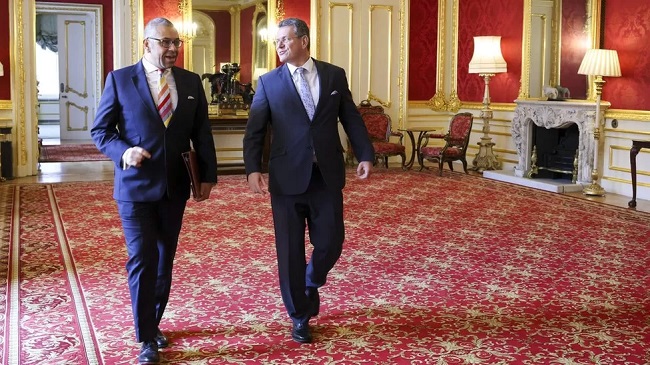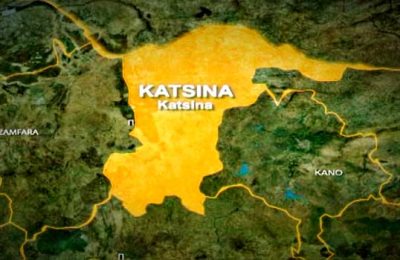
Foreign Secretary James Cleverly and EU chief negotiator Maros Šefčovič will hold a video call on Monday as momentum builds towards a new deal on the Northern Ireland Protocol. (BBC)
Last week, the EU and the UK reached an agreement on sharing trade data.

That was seen as an important step towards a wider deal.
A joint statement is expected later, but it is not yet clear if any further areas of agreement will be announced.
The agreement on sharing trade data will allow the EU to access UK IT systems, which will give detailed information about goods flowing from Great Britain to Northern Ireland.
Agreement in this area is seen as a key step to reaching a broader deal.
In a joint statement, they said technical teams would now work rapidly to find solutions.
The statement came after a meeting between Mr Šefčovič, Mr Cleverly and Northern Ireland Secretary Chris Heaton-Harris.
On Monday, shadow Northern Ireland secretary Peter Kyle warned of profound consequences if the UK and EU fail to reach a deal on the protocol.
Mr Kyle was speaking on a visit to Londonderry with Labour’s shadow foreign secretary David Lammy and the party’s Brexit spokesperson in the House of Lords, Baroness Chapman.
He said his party had not been briefed on any planned joint statement which is expected to come later on Monday, but he did say both the UK and EU needed to make use of the small “window of opportunity” to get a deal on the protocol over the line.
It’s not yet clear whether James Cleverly and Maros Šefčovič will be ready to lay out this political declaration later on Monday after they speak via video conference.
An increasing degree of secrecy has surrounded the talks, but one source has indicated that the framework will signal progress on trade issues but not the final deal.
It could even be thought of as an agreement in principle with various technical details to be worked out later.
People close to the talks have also suggested there has been very limited progress in other areas, such as the European Court of Justice’s oversight role.
However, it has been indicated that outstanding issues could be “nodded to” in any declaration.
The uncertainty and secrecy indicate that negotiators are performing a “high-wire act”, according to one European diplomat.
It’s not yet clear whether James Cleverly and Maros Šefčovič will be ready to lay out this political declaration later on Monday after they speak via video conference.
An increasing degree of secrecy has surrounded the talks, but one source has indicated that the framework will signal progress on trade issues but not the final deal.
It could even be thought of as an agreement in principle with various technical details to be worked out later.
People close to the talks have also suggested there has been very limited progress in other areas, such as the European Court of Justice’s oversight role.
However, it has been indicated that outstanding issues could be “nodded to” in any declaration.
The uncertainty and secrecy indicate that negotiators are performing a “high-wire act”, according to one European diplomat.
What is the Northern Ireland Protocol?
The protocol is a part of the UK-EU Brexit deal that keeps Northern Ireland aligned with some EU trade rules.
It keeps Northern Ireland in the EU’s single market for goods, avoiding the need for a hard border with the Irish Republic after Brexit.
However, it also creates a new trade border between Northern Ireland and the rest of the UK, something the EU accepts is causing difficulties for many businesses.
Some unionists say it is also undermining Northern Ireland’s place in the UK.
The UK says the protocol is not working and plans to override most of the agreement if the EU does not agree to changes.
One of the changes the UK has proposed is a green lane/red lane system for goods entering Northern Ireland from Great Britain, with trusted traders using a green lane for goods destined only for Northern Ireland.
The EU has accepted that goods that are staying in Northern Ireland should be subject to a lighter touch.
The UK said it has built a system which can do this by drawing together five different databases which deal with things like customs declarations, safety and security declarations and ferry manifests.
The system was demonstrated to EU officials last summer and has been working in pilot form in recent months.
The EU’s acceptance that the system works is significant, but it does not mean that a fresh agreement on the movement of goods is inevitable.
A previous stumbling block has been how much information companies need to provide when shipping goods from Great Britain to Northern Ireland, which can be a bigger problem than physical checks.
During the Christmas period, the UK said that it will soon bring forward legislation which would lead to the building of new facilities at Northern Ireland’s ports to enforce the protocol.
The government said this would be necessary for red lane checks but the lack of proper border controls posts at the ports has long been an EU bugbear.
READ FROM ALSO NIGERIAN TRIBUNE







